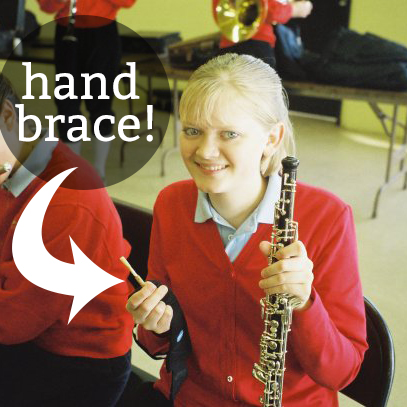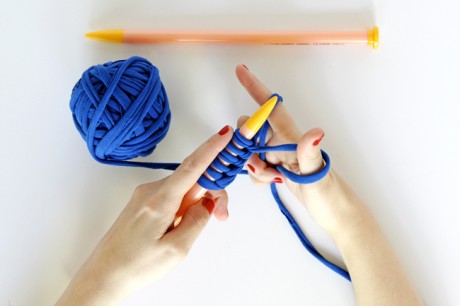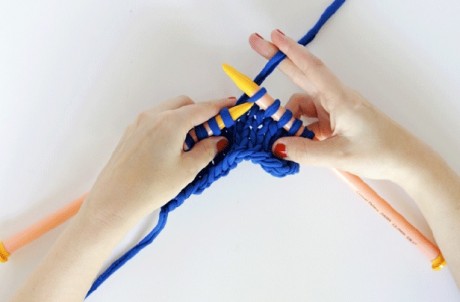When diagnosed with carpal tunnel and tendonitis, blogger Heidi Gustad was forced to put down her needles. She joins the LK blog to talk about how she rediscovered her talent for knitting.
My knitting journey began almost 20 years ago. I turned 27 this summer, so yes, I was just a kid when my grandma sat my overly anxious 8-year-old self down to knit for the first time. I had a pair of pink metal knitting needles, and some variegated blue, white and pink yarn. Unsurprisingly, I wasn’t really liking knitting at first. I tried here and there as a tween to wrestle with my insanely overtight first “scarf” but struggled to get the hang of it. Then high school rolled around and I finally fell in love.
My best friend and I were the only members of the class of 2005 who took our knitting on band trips and spent time between music rehearsals trading knitting tricks and beginner books.
Around this time, I started having pains in my right hand. I was playing my oboe, doing a lot of homework, and knitting to relax. At some point, your hands actually do need a rest (much to my adolescent disappointment). I was a 14-year-old who never stopped working with her hands, almost ever. Diagnosed with carpal tunnel and tendonitis, I was put in physical therapy, and my doctor recommended I drop something. School was non-negotiable and music was something I’d worked so hard to achieve. So I put down my needles.
A few years later, I found myself on a music scholarship struggling with my fourth or fifth bout of tendonitis and intermittent loss of feeling in my hand. It became clear that music was not a sustainable career option. At just 18, I think I realised that I wanted a slightly more well-rounded life than a career as a classical oboist would allow. (I was a very serious young lady back then!) My hands began to heal, my circle of friends grew, and the next Christmas I realised that I really, really missed knitting. More than I thought possible.
I dug out my tub of yarn and needles and got to work. My skills came back in no time. But then my tendonitis did too.

You can’t play the oboe left handed
I was faced with giving up a second creative love, and didn’t know what to do. Then I remembered my grandma, the woman who taught me to knit. She knew no left-handed knitters growing up in a rural area, so she was a leftie who’d been taught to knit right handed. If I was going to be able to keep knitting, I needed to become a primarily left-handed knitter, despite being right handed. My grandma had been doing it her whole life, why couldn’t I figure it out?
After much struggle and a little bit of a time spent practising, I mastered left-handed knitting. The hardest part was swallowing my pride and watching myself struggle (painfully slowly, no less) to make swatches and cables that’d grown used to whipping up alongside wine and my favourite movie.
I wonder what would have happened if left-handed oboes existed - I might have taken a hand-switching journey of an entirely more musical kind. You know what, though? I have a feeling everything worked out how it was meant to in the end.

Some tips for learning to knit with your non-dominant hand.
Unlike the oboe, you CAN knit left handed, right handed, or ambidextrously. Working ambidextrously is fun, especially if you’re working in short rows. It’s like the knitting version of eating corn on the cob, you work back and forth and back and forth without turning your work! Weird, right?
It was so frustrating to learn to knit from scratch again. I was at the point where I was designing some of my own patterns for myself, and very occasionally for my blog. I could cable, knit socks, sweaters, colourwork, complicated blankets. I was very happy with the level of knitting I’d achieved with my right hand, so starting over was very unpleasant at first. I sat down and swatched and swatched, and studied a lot of diagrams and YouTube videos demonstrating how your loops should sit on your needles when knitting left handed.
Here’s what doing a knit stitch left handed looks like. Notice how the loops slant to the left (instead of to the right) on the needles:

The biggest things I recommend taking the time to read about, watch videos of, and study when switching the hand you knit with are:
- how your loops should be laying on your needles
- how to cast on with your other hand
- how to do proper reductions with your other hand (all of the reductions you are accustomed to will be laying backwards if you do them working opposite handed)
Heidi is a Chicago-based blogger and librarian with a modern take on knitting, crochet and DIY. See more of her knitting patterns, inspiration and craft projects at Hands Occupied.




_333_180_c1.png)

_Craftihive_Let_s_Knit_Website_Blog_-_7.9.25_HEADER_IMAGE-01__333_180_64_c1.jpg)

_333_180_64_c1.jpg)
 Baby
Baby
 Toys
Toys
 Garments
Garments
 Crochet
Crochet
 Homewares
Homewares
 Dolls
Dolls



Share